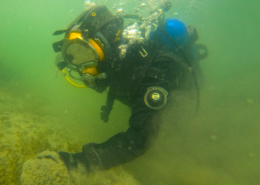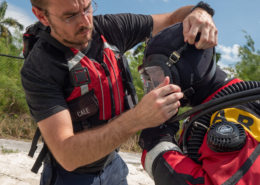Scuba vs. Surface Supplied Air
It is safe to say that the majority of public safety dive teams train using Self Contained Underwater Breathing Apparatus (SCUBA) equipment. The training for SCUBA is readily accessible and the equipment relatively inexpensive. SCUBA is also easy to maintain and transport. Teams with large budgets, or more diverse areas of responsibilities, may have acquired and trained with Surface Supplied Air (SSA) equipment. SSA equipment is more expensive, requires specialized training and the components require large areas for storage and deployment. Due to these comparisons, public safety dive teams use what they have on hand, SCUBA equipment, to conduct their missions. However, there are times when a public safety dive team may want to look outside their normal operations in order to save time and money executing a mission.
A tip from a fisherman
Our Police Department recently took a report of 60+ handguns stolen during a burglary. There was no sign of the stolen weapons until a local fisherman brought in a rusted and corroded handgun he stated that he hooked while fishing from a local pier. When the gun was confirmed stolen from that burglary, the dive team was assigned to check the area for more stolen weapons. The team took the fisherman to the location and he did his best to describe where he was fishing when he hooked the stolen weapon. While evaluating the search area, it was obvious that it could be wide and vast. The fishing pier was long with a 90 degree turn and all of it accessible to the water. The suspect could have thrown the additional weapons at numerous locations.
The pier was at such a height above the water line, even at a high tide, that it would have been a dangerous drop to the water. There was also no way to help a diver in the water with recovering a weapon. The dive team decided to use the equipment at hand, SCUBA, and the dive boat, in order to stay close to the water, even though it was not the most stable platform. During the first mission, two weapons were recovered. This required two divers, one boat operator, 4 SCUBA cylinders and approximately 4 hours.
Opening up a can of worms
After this initial recovery dive it was determined that a large number of the stolen weapons could have been dumped in this area. Looking at logistics, it could take several days, numerous cylinders and numerous personnel, many on overtime, to thoroughly check the area and recover all of the potentially dumped weapons. Like every team, ours needed to monitor the budget of the dive mission to keep the support of the department. We decided that we needed to come up with a more feasible, cost effective plan.
Moving from Scuba to Surface Supplied Air
Our team did not have Surface Supplied Air (SSA) equipment, but one of our members did. The dive team member had the SSA equipment and some volunteers to help tend topside on the boat. The reason the team thought about using SSA equipment was due to analyzing the time necessary for a SCUBA diver to change out his cylinder every 40 minutes while diving at approximately 40 feet. Using SSA, there is no changing of a cylinder and the diver can stay down as long as he avoids decompression. At 40 feet decompression did not become an issue until over 2 hours.
Surface supplied air equipment is costly, and difficult to set up, but it has numerous advantages over SCUBA. As long as the compressor runs, the diver has air. If the compressor stops, the diver has an emergency air supply located on the boat, as well as an emergency bailout bottle mounted on his back. The diver is attached to an umbilical line, which contains the air hose, as well as a safety line and communication line. The communication is hard-wired; therefore it is more reliable than wireless systems. Another advantage is that the umbilical line can also act as the search pattern line.
Eight Weapons Recovered in 3 hours
For the next search mission, using surface supplied air, the dive boat was located just under the pier. When the SSA diver went down, the tender controlled his search pattern. The diver started at the location estimated to be the farthest possible for any person to throw an object. A search pattern was used to slowly work the diver back towards the fishing pier. The first two hours concluded with negative results. However, the depths were shallower than previously planned, and the diver was able to stay in the water. After 2 hours in the water, the diver recovered the first weapon. The dive mission continued for an additional 1 hour and 15 minutes, with a total recovery of eight more stolen weapons. The total dive time was 3 hours 15 minutes using SSA and 2 Aluminum 80 SCUBA cylinders.
Working as a team
The SCUBA cylinders were used by a group of two back-up divers. The SSA diver would communicate that a weapon was located. Topside would send the SCUBA diver down the umbilical line to the SSA diver. The location was marked and the weapon placed into a bag. The SCUBA diver would then bring the weapon to the surface. In the meantime, the SSA diver would continue with the search pattern, never having to leave the bottom, and never losing his location or doubting if an area had been fully searched.
Using surface supplied air equipment, the dive team was certain that the entire area had been searched. One diver stayed in the water using SSA, staying well outside decompression exposure limits. The backup divers were only used as safety divers and to retrieve the recovered weapons. This limited the amount of air used and their decompression exposure. The entire operation was completed in one day, and with less than 5 hours of actual mission time. This time reduction saved the dive team and department thousands of dollars in overtime, equipment maintenance and fuel costs.
Conclusion
I am not advocating that all teams spend the time and money outfitting for surface supplied air operations. The costs are exorbitant related to the actual number of missions where SSA is more feasible than SCUBA. However, there are times when other styles of diving, such as SSA, can save the team money and make the mission safer. The dive team needs to think outside the box, analyzing what they are looking for, where they are looking and the costs of completing a successful mission.
There is one more concern not covered in this article. Like the saying goes…. Cost of surface supplied air equipment and training: thousands of dollars. The cost of a SSA diver investing in a urine dump valve: PRICELESS.




 Y. ZIN
Y. ZIN




Lascia un Commento
Vuoi partecipare alla discussione?Sentitevi liberi di contribuire!